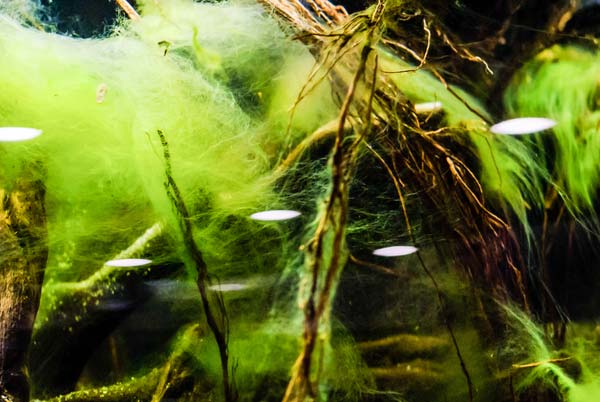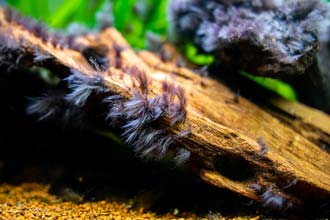Algae Growing On Plants: What It Means and How to Fix It
Posted by Miles Harrison on 09/14/2022
We use affiliate links and may receive a small commission on purchases.
One of the most frustrating aspects of freshwater aquariums is battling algae. It seems like no matter what we do to maintain pristine water conditions, occasionally algae blooms are inevitable. In planted tanks, algae problems can quickly spiral out of control, as high light and CO2 provide a perfect breeding ground for algae to thrive. In this post, we’ll discuss the common culprits for algae blooms, how to prevent them, and what to do if algae has already taken hold.
January's Giveaways on Light Fish
What causes algae to grow on plants?
In a freshwater planted aquarium, algae growth is almost always attributed to 5 variables: too much light, not enough CO2, poor water circulation, lack of nutrients, or a sudden change in water chemistry, such as an ammonia spike.
There is a golden rule in aquascaping, and that is when given ideal water conditions, plants will always outcompete algae for nutrients. That being said, let’s circle back to the 5 causes of algae, and establish goals for each cause.

🛒 Shop Freshwater Fish on Light Fish
Too Much Light
Excessive light is usually suspect #1 in planted aquariums with algae. One thing I see often with beginner hobbyists is that they will purchase expensive lighting fixtures in an attempt to grow demanding aquatic plants. While it’s true that high light is needed for certain plants to thrive, one thing that gets overlooked is plant biomass. If you don't have a fully carpeted substrate with a nice variety of fast growing plants (hornwort, various rotala species), that occupy at least 50% of the aquarium, you cannot run high intensity lighting. You will run into algae issues if you attempt to do this!
People often see Iwagumi scapes and think a low biomass can thrive with high light, what they don’t see with these scapes is the large amount of water changes that are done almost daily. This is common practice for famous tanks, such as the ones designed by Takashi Amano. In addition, a lot of times the lighting intensity is reduced for most of the day and is only cranked back up to full blast for the “money shot” which you often see on aquarium forums, social media, etc.
If you don’t have control over lighting intensity, and raising the light fixture is not an option, some options for relief include adding a lid to the aquarium, as well as adding a substantial amount of floating plants. These floating plants will help absorb light.
Not Enough CO2
Having too little available CO2 is problematic in a planted aquarium where plants have high light demands. One of the most common types of algae that emerge when there’s a lack of CO2 includes black beard algae and green dust algae. Excessive amounts of CO2 are usually a non-issue. As long as there is sufficient gaseous exchange, which can be achieved by having a strong current and surface agitation, fish will have an ample supply of oxygen and won’t need to swim near the surface for oxygen.
Poor Water Circulation
3rd on our list of what causes algae to grow is poor water circulation. You’ll need to have water flow throughout your aquarium. In high-light tanks, water flow is crucial, you’ll want to consider adding a power head and/or a surface skimmer to promote gaseous exchange. In low-light tanks, you have a bit more flexibility. The small waterfall created by a HOB (hang-on-back) filter is usually enough for a non-co2, low light, planted tank.
Nutrient Deficiency
Nutrient dosing is a requirement in planted aquariums. For low to medium-light aquariums, semi-daily store bought nutrient dosing is usually enough to reach sufficient levels. However, if you have a CO2 injected aquarium, we recommend direct dry dosing and the Estimative Index dosing method. This dosing method, combined with a 50% weekly water change, eliminates any possibility that your aquarium will have an insufficient supply of nutrients. While we won't get into the specifics of this dosing method, there are excellent guides online.
Sudden Swings in Water Chemistry
Last on the list are sudden changes in water chemistry. Most likely this won’t be the cause of an algae bloom. So be sure everything else is in check. Typically, an aquarist will be aware of the cause. Common causes of this include excessive feeding and dead livestock.
Now that we’ve discussed all of the causes, let’s move onto solving these issues.
How can I prevent algae from growing on my plants?
You can prevent algae from growing on your plants by doing weekly 50% water changes, dosing the appropriate nutrient levels, maintaining proper lighting and CO2 levels, and by having good circulation throughout the tank. Algae prevention can be achieved by having a large biomass of healthy fast-growing plants.
You can bolster this by adding livestock that are known to eat algae. We recommend Cherry Shrimp, Amano Shrimp, Assassin Snails, Otocinclus, and depending on existing tank mates, Siamese Algae Eaters. This clean up crew will help consume algae and aid in prevention.
How can I fix algae growing on my plants?
Now that you know about the 5 variables that can cause algae, you might be wondering how to solve an existing algae infestation.
Luckily, there are steps you can take to fix a tank overrun by algae.
The first step is manual removal. Try to remove as much algae as possible, algae scrapers are great for this. Trim off any badly infested leaves. A toothbrush will also work well to pull up any hair algae, but be careful not to unroot any existing plants. We also recommend overdosing Excel . Overdosing Excel is a great solution to kill off any black beard algae (typically the hardest type of algae to remove, often induced by a lack of CO2 and too much light.) After you’ve taken these steps, perform a large, 60-70% water change. Be mindful of any tank inhabitants that might suffer from a large water change. Perform the change slowly so that your livestock is able to adapt to the sudden change in water conditions.
Next step is a 3-day blackout. Cover the aquarium with black garbage bags or towels, and ensure that no light can enter any area of the tank. Existing livestock and plants will be fine for this 3 day period. Try not to look in the aquarium during this period, we don’t want any light to be consumed by any of the existing algae.
After the 3-day period, clean the aquarium once more and do another 50-60% water change. At this point, your aquarium should be in much better shape, most hair algae should have died off and black-beard algae may begin to turn reddish/pink indicating dieoff.

At this point, you’ll need to make a judgment call - how much of the algae still exists in the aquarium? If it’s less than 10% of the initial amount, confirm that all 5 of the algae inducing variables are accounted for. At this point your tank should be stable, and plants should outcompete any remaining algae, ultimately resulting in die-off, further bolstered by any clean up crew members you have.
If there is still a decent amount of algae remaining (> 10%), repeat the initial steps until you can get to that 10% mark.
Conclusion
Now you know everything there is to know about the causes of algae growing on plants in a planted tank, and have solutions in place to fix them.
As long as you’re disciplined in ensuring the 5 variables are always being accounted for, you’ll be able to enjoy the benefits of having a beautiful aquascape in your home for years to come!
January's Giveaways on Light Fish






